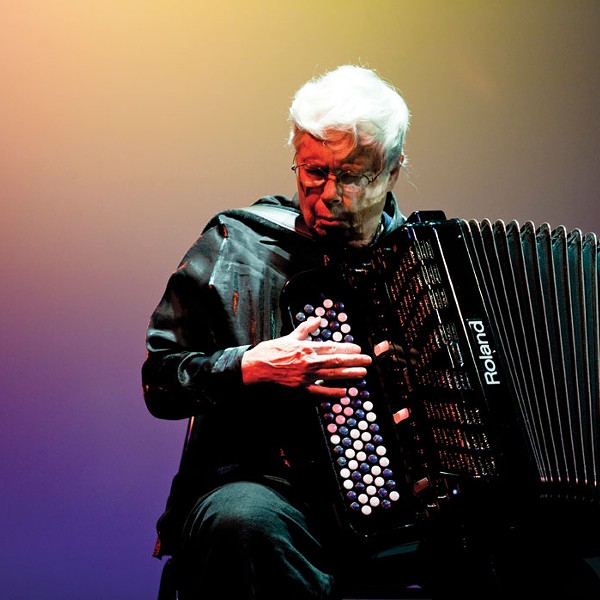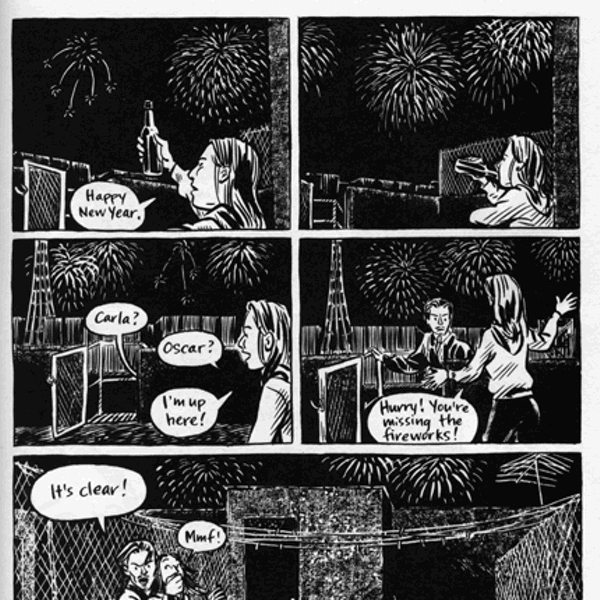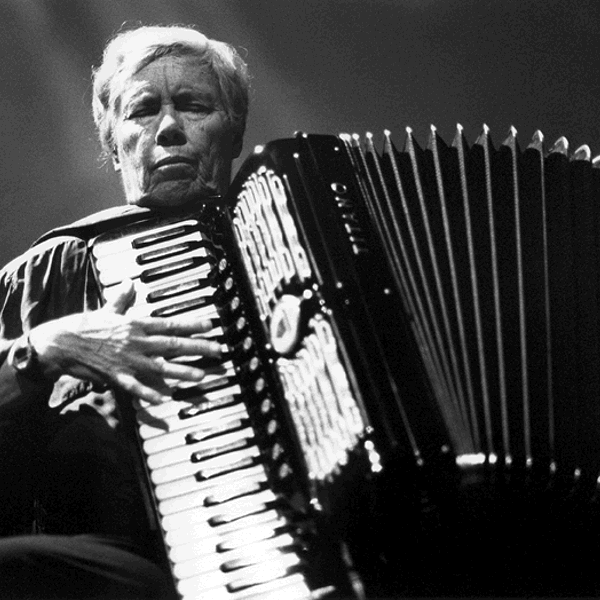After 15 years of publication it was, quite honestly, shameful that while Chronogram has frequently covered events in which she is involved, the magazine had yet to profile Pauline Oliveros. A maverick icon known around the world, the Kingston composer is recognized as a leading figure in the development of electronic music. Over her 40-year career, she has formulated the influential theories of Deep Listening, sonic awareness, and the Expanded Instrument System; was a founding member and the first director of the vanguard San Francisco Tape Music Center; created the Deep Listening Institute, which regularly conducts programs and events nationally and abroad; authored four books; and served on the faculties of several prominent colleges. The occasions of her 77th birthday and its celebratory concert this month seemed like the perfect opportunity to finally feature this remarkable woman in our pages.
And so there here we are, in the brightly painted Rondout Victorian that Oliveros shares with her longtime companion, the writer and spiritual counselor Ione. It’s a gray day outside but there’s no shortage of color in here. As befits a pair of well-traveled artists with mystical and wide-ranging interests, the stately home’s rooms are lined with tall stacks of books and adorned with paintings and totems from Africa and the Far and Middle East. Mention of having prepared for the interview by reading Oliveros’s various online bios elicits from her a relaxed and characteristically telling response: “Oh, let’s just talk.”
Generally, with artists it’s either a situation of pulling teeth to gain a few kernels of insight, or of attempting to corral the proceedings back in line to get a word in edgewise, as the subject throws open the floodgates at the chance to finally speak their piece. But in Oliveros’s case it seems the words “talk” and “listen” are on an equal plane, tacitly interchangeable. A conversation with her is remarkably—startlingly, actually—well balanced. True to the Deep Listening practice she developed in the 1980s, Oliveros seems to intently hear the question behind the question. Every query brings forth a clear and direct response, though never one that lacks for suggestiveness.
“The paradigm is that we are a visual culture,” she says when asked about the ideas behind Deep Listening and sonic awareness, the latter defined as the ability to consciously focus attention upon environmental and musical sound, requiring continual alertness and an inclination toward always listening. “People mostly rely on their eyes [to observe], but by doing that they miss the world around them. When we learn to become better listeners, we learn more about ourselves, as well as each other. Sound and emotion are directly related, and we’re conditioned to repress both. We tend to be more connected emotionally and in every other way when, instead of automatically tuning out things we learn to ignore—like that car with the beat-box music [as if on cue, a car playing loud hip-hop drives by outside], or that heater [a radiator in the next room hisses on]—we learn to appreciate the sounds around us. They center us and remind us of our place in the world.”
Oliveros entered the world through the portal of Houston, Texas, in 1932. Her father left to join the Coast Guard during World War II and never returned; her mother and grandmother, both piano teachers, introduced her to the classics, and she learned about folk music from the locals. “We had a chicken farm and lived just outside the city. On weekends there would be string bands playing for tips up the road at the icehouse, which was what you’d call the general store,” she recalls. “There were no refrigeration systems then, at least not where we lived. I can still remember the clink of the iceman’s pincers.” One day, when Oliveros was nine, in an effort to bring in more income by adding more lessons to her curriculum, her mother brought home an accordion. Taken with the instrument right away, she was soon a member of a 100-piece accordion orchestra that appeared at indoor rodeos. “The sound of that many accordions going at once—oh boy, has that stayed with me,” waxes the composer. Although she did put it aside for a few years in the early 1970s to concentrate on writing, Oliveros has continued to make her name as an accordion avatar, taking the instrument to previously unheard plateaus through her use of electronic effects and other treatments and unusual settings.
In 1952 she transferred to San Francisco State College (“with my accordion and $300 in my pocket”), where she studied under pivotal modernist composer Robert Erickson. While at SFSC she met fellow student-composers Terry Riley, Steve Reich, Ramon Sender, Loren Rush, and others, all of whom, like many of their European peers, were finding that standard musical scores did not reflect the sounds they wanted to make. In 1961 Oliveros and her compatriots founded the improvisation group Sonics, which later evolved into the San Francisco Tape Music Center, a nonprofit cultural and educational corporation with the aim of presenting concerts and offering a place to learn about the then-cutting-edge medium of tape music. “You had all of these GIs bringing back this new magnetic tape from Germany, and we had one of the first tape machines, an Ampex,” says Oliveros. “I’d used wire recorders before, but with them you couldn’t do what you could with tape.” By using the devices’ record and playback heads in unconventional ways, she pioneered the use of tape loops and long delays, which the collective presented at events that often combined live instruments and theatrics. Composer Morton Subotnick, who was also working in the medium while teaching at nearby Mills College, soon joined the group, which continued to grow and spread its influence through regional and national tours before being assimilated into Mills College’s Center for Contemporary Music.
It was during these years that Oliveros created several of her most enduring works, pieces now held as classics of electronic music: 1965’s “Bye Bye Butterfly,” which weaves an operatic recording into its mix of quiet, spooky electronic tones; 1966’s “I of IV,” a sci-fi-esque effort that applies her Expanded Instrument System by using oscillators set beyond the frequencies of normal hearing and feeding their amplified harmonic “difference tones” through a system of tape-delay mechanisms; and “Big Mother Is Watching You” (also from 1966), whose womb-like isolationism and oceanic waves presage Brian Eno’s ambient work as well as that of ’90s stylists like the Orb and Aphex Twin.
“Pauline Oliveros was very different from other [1960s] electronic music pioneers in that she thought of creating music that was a continuous, unraveling thread,” says AllMusic.com’s classical editor, Uncle Dave Lewis. “Her projection of long, unfolding events was something that didn’t have an obvious parallel in nonelectronic Western music but was organic in relation to electronic music itself, and this opened up a whole new way of approaching both the medium and art music in general.”
In 1967 Oliveros took a teaching position at the University of California at San Diego, studying with theoretical physicist Lester Ingber and learning ways to apply his methods to music; Ingber, a martial arts instructor as well, also mentored her in karate. Oliveros went on to become a black belt. (Although she no longer practices its physical aspects, she maintains that karate’s mental disciplines, as well as those of tai chi, qigong, and yoga, are central to the meditative approach of her musical techniques.) But after serving as UCSD’s Center for Music Experiment for 14 years, Oliveros began to feel creatively stifled by program dictates. “I guess I was a little radical back then,” she says. “And the way it was at that time, I was starting to feel like maybe I’d joined the establishment, which I didn’t want to do.” And so following almost three decades on the West Coast she left the college to focus on composing, performing, and artistic consulting. Drawn to the Hudson Valley through her work with Woodstock’s Creative Music Studio and her visits to Mount Tremper’s Zen Mountain Monastery, as well as the area’s proximity to New York, she moved to Kingston in 1981.
While quickly becoming a pillar of the local arts community, Oliveros continued to build a following through her concerts, recordings, and dance and theatrical scores, and acted as an advisor to the National Endowment for the Arts, the New York State Council for the Arts, and other groups. In 1985 she founded the Pauline Oliveros Foundation, a humanitarian/arts organization that would eventually be rechristened the Deep Listening Institute, named for both the concept itself and the revolutionary Deep Listening Band. Formed in 1988, the Deep Listening Band includes Oliveros on accordion, Stuart Dempster on trombone and didgeridoo, and David Gamper on keyboards and electronics (vocalist and founding member Panaiotis left in 1993), and specializes in playing and recording in ultraresonant or ultrareverberant spaces such as caves and cathedrals. The group debuted with a performance in a two million-gallon water cistern at Washington State’s Fort Worden, and has since released several recordings that display its singularly supernatural mastery of sound, environment, and the interaction between the two; the double-LP anthology Then & Now Now & Then (Taiga Records, 2008) features “Cannery Row,” which was recorded in Rosendale’s Tarpaper Cave in 1990 and makes full atmospheric use of the site’s rushing underground stream. To celebrate the 21st anniversary of its first performance, the Deep Listening Band will return to Fort Worden for a concert on May 21.
In addition to her never-ending musical pursuits, Oliveros has been unwavering in her leadership of the Deep Listening Institute, which is dedicated to imparting its philosophy and approach to heightened hearing through workshops and retreats around the world. And since her break with UCSD, Oliveros has re-entered traditional academia—this time on her own terms. During the fall season she serves as Mills College’s Darius Milhaud Professor of Composition and in 2000 she became Distinguished Research Professor of Music at Troy’s Rensselaer Polytechnic Institute. (At RPI Oliveros has given several performances, including a 2008 concert with jazz great Cecil Taylor.) Clearly, she’s not settling into the easy chair any time soon.
“Yeah, I’d have thought I’d be slowing down by this point,” she says with a laugh. “But it just seems to get busier. A lot of it seems to be technology-driven. More and more projects are coming my way all the time, thanks to the Internet. I couldn’t do a lot of what I do now if we were back writing letters instead of e-mails.”
“Pauline Oliveros, my dear friend of 40 years, has always trod the path of deep contemplation and awakening to the power of sound,” says Terry Riley. “Her honesty, wisdom, and courage have inspired and instructed countless individuals. She has manifested a large catalog of works of great vision and beauty.”
An overview of that catalog will soon be available through Deep Listening Records in the form of Sounding the Margins (as it was), a six-CD box set chronicling four decades of Oliveros’s formidable career. “To me, perfection in sound is to always be really surprised by what you hear,” she says. “The surprises are what delight me the most.”
Pauline Oliveros will play a solo concert at The Stone in Manhattan on May 9. A salon concert in honor of her 77th birthday, featuring Oliveros and Benton-C Bainbridge, will take place at Deep Listening Space (inside the Shirt Factory building) in Kingston on May 30. For more information: www.deeplistening.org.


















